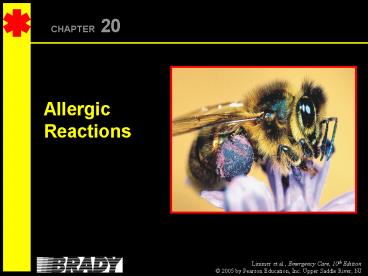Allergic Reactions - PowerPoint PPT Presentation
1 / 44
Title:
Allergic Reactions
Description:
CHAPTER 20 Allergic Reactions What is your impression of Mr. Meeker s condition? What do you think might be happening to him? What do you suspect is beginning to ... – PowerPoint PPT presentation
Number of Views:248
Avg rating:3.0/5.0
Title: Allergic Reactions
1
CHAPTER 20
Allergic Reactions
2
AllergicReactions
3
Key Term
Allergic Reaction
An exaggerated reaction by the bodys immune
system to any substance
4
Key Term
Anaphylaxis
A life-threatening allergic reaction which causes
shock (hypoperfusion) and airway swelling
5
Common Allergens (Causes) of AllergicReactions
Insect stings
Plants
Foods
Medications
6
Signs and Symptoms
Skin
- Itching
- Hives
- Flushing
- Warm, tingling feeling
- Swelling (especially face, neck, hands,
feet, tongue)
7
Signs and Symptoms
Respiratory
- Tightness in throat/chest
- Cough
- Rapid, labored, noisy breathing
- Hoarseness
- Stridor and wheezing
8
Signs and Symptoms
Cardiac
- Increased heart rate
- Low blood pressure
9
Signs and Symptoms
Generalized Findings
- Itchy, watery eyes and runny nose
- Headache
- Sense of impending doom
10
Signs and Symptoms
- Decreasing mental status
- Signs and symptoms of shock (hypoperfusion) or
respiratory distress
11
Assessing Allergic Reactions
- Initial assessment
- Focused history and physical exam
- Baseline vital signs
- SAMPLE history
12
Assessing Allergic Reactions
- Any history of allergies?
- What was patient exposed to?
- How was the patient exposed?
- What signs and symptoms does the patient have?
13
Assessing Allergic Reactions
- Any progression of the signs and symptoms?
- Have any interventions been performed on the
patient?
14
Obtain SAMPLE history.
15
Apply high-concentration oxygen.
16
Take baseline vital signs.
17
If the patient meets the criteria, assist
in administering the patients own epinephrine.
18
Emergency Care of Allergic Reactions
- Reassess in 2 minutes.
- Record reassessment findings.
- If patient does not have epinephrine
auto-injector, transport immediately.
19
Emergency Care of Allergic Reactions
- Epinephrine needed if the patient
- Has come in contact with something that caused an
allergic reaction in the past,
AND IF - The patient has a prescribed epinephrine
auto-injector, AND
IF
Continued
20
Emergency Care of Allergic Reactions
- Patient shows signs and symptoms of shock
(hypoperfusion) OR - Complains of respiratory distress
(Sometimes BOTH)
21
Emergency Care of Allergic Reactions
- When the patient does not have a
- prescribed epinephrine auto-injector
- Treat for shock.
- Request ALS.
- Transport immediately.
22
Emergency Care of Allergic Reactions
- When the patient does not have
- respiratory distress or shock
- (hypoperfusion)
- Continue with focused assessment.
- Consult medical direction for possible
administration of epinephrine.
23
Relationship to AirwayManagement
24
Note
The patient may need aggressive airway management
immediately because of swelling in the airway or
respiratory compromise.
25
Note
The patients condition may be stable initially
but deteriorate to the point where he/she needs
aggressive airway management.
26
Use of Epinephrine Auto-Injector
27
Epinephrine
Indications
- Signs of allergic reaction
- Physician has prescribed epinephrine to
patient - Medical direction authorizes epinephrine
28
Epinephrine
Contraindications
NONE, when used in life-threatening situations
Medication Form
- Auto-injector
29
Epinephrine
Dosage
- Adult One auto-injector
- Child One pediatric auto- injector
30
Epinephrine
Administration
- Injector prescribed for
- THIS patient?
- Expiration date?
- Liquid cloudy or discolored?
31
If medical direction authorizes epinephrine,
remove safety cap.
32
Place injector against patients thigh midway
between waist and knee. Push and hold for 10
seconds.
33
Dispose of injector and recordadministration.
34
Epinephrine
Actions
- Dilates bronchioles
- Constricts blood vessels
35
Epinephrine
- Increased heart rate
- Pallor and dizziness
- Chest pain
- Headache, excitability, and anxiety
- Nausea and vomiting
Side Effects
36
Epinephrine
Reassessment Strategies
- Transport.
- Continue focused assessment of airway,
breathing, and circulation.
37
Epinephrine
Reassessment Strategies
- If patients condition WORSENS
- Consult medical direction about another dose.
- Treat for shock.
- Be prepared to use CPR/AED.
38
Epinephrine
Reassessment Strategies
- If patients condition IMPROVES
- Continue oxygen.
- Treat for shock (hypoperfusion).
39
Review Questions
1. Define an allergic reaction. 2. List some
common causes of allergic reactions.
40
Review Questions
3. List signs and symptoms of an anaphylactic
reaction associated with the skin, respiratory
system, and cardiovascular system.
41
Review Questions
4. Tell how to determine whether the patient
needs epinephrine. 5. Explain how to administer
epinephrine. 6. Describe the actions and side
effects of epinephrine.
42
STREET SCENES
- What is your impression of Mr. Meekers
condition? - What do you think might be happening to him?
43
STREET SCENES
- What do you suspect is beginning to happen to
your patient? - What further treatment should you render?
44
Sample Documentation































